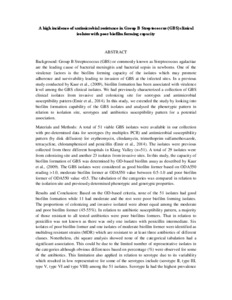Citation
Ezhumalai, M. and Amin Nordin, Syafinaz and Mohd Desa, Mohd Nasir
(2015)
A high incidence of antimicrobial resistance in Group B Streptococcus (GBS) clinical isolates with poor biofilm forming capacity.
In: Infections 2015, 7-8 Apr. 2015, IOI Marriot Putrajaya, Malaysia. (p. 31).
Abstract
Background: Group B Streptococcus (GBS) or commonly known as Streptococcus agalactiae are the leading cause of bacterial meningitis and bacterial sepsis in newborns. One of the virulence factors is the biofilm forming capacity of the isolates which may promote adherence and survivability leading to invasion of GBS at the infected sites. In a previous study conducted by Kaur et al., (2009), biofilm formation has been associated with virulence level among the GBS clinical isolates. We had previously characterized a collection of GBS clinical isolates from invasive and colonizing site for serotypes and antimicrobial susceptibility pattern (Emir et al., 2014). In this study, we extended the study by looking into biofilm formation capability of the GBS isolates and analysed the phenotypic pattern in relation to isolation site, serotypes and antibiotics susceptibility pattern for a potential association.
Materials and Methods: A total of 51 viable GBS isolates were available in our collection with pre-determined data for serotypes (by multiplex PCR) and antimicrobial susceptibility pattern (by disk diffusion) for erythromycin, clindamycin, trimethoprim sulfamethoxazole, tetracycline, chloramphenicol and penicillin (Emir et al., 2014). The isolates were previous collected from three different hospitals in Klang Valley (n=51). A total of 29 isolates were from colonizing site and another 23 isolates from invasive sites. In this study, the capacity of biofilm formation of GBS was determined by OD-based biofilm assay as described by Kaur et al., (2009). The GBS isolates were considered as good biofilm former based on ODA550 reading >1.0, moderate biofilm former at ODA550 value between 0.5-1.0 and poor biofilm former of ODA550 value <0.5. The tabulation of the categories was compared in relation to the isolation site and previously determined phenotypic and genotypic properties.
Results and Conclusion: Based on the OD-based criteria, none of the 51 isolates had good biofilm formation while 11 had moderate and the rest were poor biofilm forming isolates. The proportions of colonizing and invasive isolated were about equal among the moderate and poor biofilm former (45-55%). In relation to antibiotic susceptibility pattern, a majority of those resistant to all tested antibiotics were poor biofilms formers. That in relation to penicillin was not known as there was only one isolates with penicillin intermediate. Six isolates of poor biofilm former and one isolates of moderate biofilm former were identified as multidrug resistant strains (MDR) which are resistant to at least three antibiotics of different classes. Nonetheless, chi square analysis showed none of the categorical tabulation had a significant association. This could be due to the limited number of representative isolates in the categories although obvious differences based on percentage (%) were observed for some of the antibiotics. This limitation also applied in relation to serotype due to its variability which resulted in low representative for some of the serotypes include (serotype II, type III, type V, type VI and type VIII) among the 51 isolates. Serotype Ia had the highest prevalence (n=22) but interestingly 20 of them were poor biofilm formers. For the other respective serotypes, the distribution rate in relation to moderate and poor biofilm were about equal. As far as this study is concerned, there is no specific preference for colonizing and invasive GBS isolates to have certain advantage in term of biofilm capacity. In a study conducted by Talat et al., (2012), serotype Ia and IV were associated with tendency to form biofilm which was in contrast with this study. The tendency of antibiotic resistance to present more among poor biofilm formers in this study are also of the interest to be further elucidated. Further studies also required to define more precisely the effect of antibiotic resistance in biofilm forming GBS isolates.
Download File
![[img]](http://psasir.upm.edu.my/65590/1.hassmallThumbnailVersion/A%20high%20incidence%20of%20antimicrobial%20resistance%20in%20Group%20B%20Streptococcus%20%28GBS%29%20clinical%20isolates%20with%20poor%20biofilm%20forming%20capacity.pdf)  Preview |
|
Text (Abstract)
A high incidence of antimicrobial resistance in Group B Streptococcus (GBS) clinical isolates with poor biofilm forming capacity.pdf
Download (41kB)
| Preview
|
|
Additional Metadata
Actions (login required)
 |
View Item |

